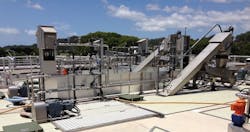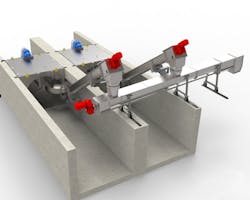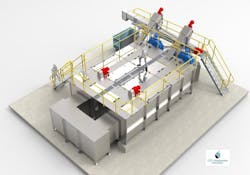About the author:
Brent Whyte is a writer for CST Wastewater Solutions. Whyte can be reached at [email protected].
The advanced wastewater fine screening technology from CST Wastewater Solutions features headworks designed for easy installation, high screening efficiency and low-maintenance over diverse municipal wastewater treatment applications encountered throughout North America.
The horizontal in-channel rotary drum screening technology has already been shown to be effective in some of the notoriously variable conditions of its native country of Australia, where it has been installed to perform cost-efficiently while curtailing blockages, environmental spills, maintenance and associated occupational health and safety issues (OH&S) in conditions that can quickly switch from drought to flood, and from sandy and stony to muddy and lush.
“Efficient headworks are vital to all the downstream purification and recycling process stages in a wastewater treatment plant, regardless of the location and input,” said Michael Bambridge, CST Wastewater Solutions managing director. “Unless solids are efficiently separated out from wastewater at the start of the purification process, you are inviting trouble into the system, and this can cost operators dearly in terms of downtime, environmental risk and clean-up costs and OH&S hazards for the teams involved.”
Bambridge, who has more than 30 years of wastewater installation and operational experience throughout the Asia-Pacific region, said the municipal and industrial applications and inputs for how this rotary fine screen technology is engineered reflect the diverse inputs and needs encountered by different municipalities, including those throughout the US.
He noted many municipalities in the U.S. are lean, with fewer staff members and may not have the capital outlay to make purchase that could result in more hired staff. As such, he said the company sought to engineer its equipment with a maintenance mindset first.
“The system is built to be versatile, flexible and robust, because these tasks vary not only from place to place, but day-to-day and week-to-week as loads on the system change,” he said. “Wastewater treatment plants (WWTPs) have to respond continually to the separation of coarse solids (ranging from sand, rocks, wood, foliage, sanitary products, toilet paper, grease, mixed food products and commercial waste), to prevent blockages and obstructions in downstream biological and/or physical processes, while minimizing the overall operating strain on the plant and staff.”
The in-channel technology implemented for this equipment has lower fluid head loss at peak flows to increase solids removal efficiency compared with typical traditional screening at wastewater treatment plants in North America.
“Advantages of this technology when dealing with fine screening of larger flows (5 mm or finer screening on flows up to 2,000 liters per second) include mechanical simplicity, self-cleaning and high efficiency screening for reduced maintenance and cheaper whole-of-life costs compared with other types of screens, such as band and inclined drum screen designs, for example,” Bambridge said.
Horizontal Drum Functionality
Critical to this functionality is the configuration of the design, in which the screening drum is installed horizontally semi-submerged in line with the incoming wastewater. The plate at the back of the drum redirects flow radially through the mesh to optimize solids separation and self-cleaning.
The rotary drum is manufactured from either self-cleaning wedge wire for primary screening, or perforated plate for fine pre-membrane bioreactor (MBR) screening. It is washed by a system of spray nozzles at a moderate pressure.
This screening technology—available in 2 mm and 3 mm hole or 3 mm wedge wire—provides for optimal adjustment of screen gap widths and sieve hole diameters for the appropriate screening result when matched to individual installations characteristics such as the application flow and local site conditions.
An internal hopper collects the screenings, which are flumed out to the integral lifting and dewatering screw, to efficiently dewater and reduce screenings volume.
The lifting screw is shaftless to avoid blockages, even in the presence of fibrous products, and includes screen and screening washing. Lifting and screenings handling can also be conducted outside the channel, which increases options for additional washing and dewatering, according to
individual applications.
“Screening and the solids lifting and dewatering are separate operations, using high efficiency screening technology to convert the high-flow, low-solids wastewater to low-flow, high-solids dewatering,” Bambridge said. “Separate screening and lifting equipment makes access simpler for more cost-effective housekeeping and maintenance for lower whole-of-life costs.”
The 8 Advantages of Horizontal Drum Design
- It lowers operating depth and range to reduce average screen velocities for higher removal efficiencies, and easier cleaning.
- It increases available open area for equivalent operating depth, enhancing functionality.
- Construction can be tailored to local conditions as the one-piece, closed drum is fully assembled in a frame for installation into a channel. It incorporates an inlet seal that can be replaced without removing all equipment from the channel.
- All parts that are subject to routine maintenance are located above the sewage flow, to simplify maintenance and reducing OH&S issues.
- Screening and lifting screw equipment are proven, simple and robust technologies. No bearings or other high maintenance moving parts are located in the wastewater. Housekeeping and servicing are conducted from above the flow channel. No mechanical devices are used inside the screen drum.
- Open entry for clean collection of solids means no rag wrapping, and reduced maintenance and OH&S issues. The screen zone of the lifting screw incorporates a washing system to reduce the contents of faecal matter in the screenings.
- Horizontal drum design also obviates any issues with band screens and bar screens with linked belt types subject to higher maintenance, or chain- and link-driven and submerged parts of the drive.
- Horizontal design also avoids issues that may arise with inclined drums, including:
- Higher maintenance costs and downtime with seal and brush replacements cycle times;
- Poor screenings removal as inclined drums tend to recycle back to the inlet, which is not ideal for MBR protection;
- Combined screenings handling, making for inflexible operation;
- Front bearing that collects screening and rags, which can foul with the seal and cause early failure; and
- Operators cannot see inside the drum to check on the integral lifting screw operation and general equipment maintenance.
Detail Makes a Difference
In addition to inherent advantages of horizontal drum concept, the CST design incorporates detail and operational features chosen on the basis of practical experience over many decades of work on municipal and industrial wastewater treatment plants.
The features focused on ease of installation, longevity and maintenance, include:
- Low-profile screens that are supplied fully assembled ready for simple and clean installation. Their design and screen aperture options permit the system to be matched individually and flexibly to multiple applications;
- The design features independent screen and screening handling, which makes systems adaptable for a variety of conditions. The screen converts high flow and low solids to low flow and high solids, promoting efficiency and longevity;
- Screenings flumed as low flow and high solids out of the drum and can be drained in an integral lifting screw or flumed to outside handling system, offering further flexibility and simplicity;
- Solid drum design with a closed-off end and only one inlet for reliability and simplicity of maintenance. The main bearing is located downstream out of the main high solids flow and below design flow level. The water-flushed non-metallic bearing, designed to suit in-channel conditions, has an expected life of seven to 10 years;
- A static inlet lip seal with stainless steel insert, which runs inside a machined recess engineered for effective sealing with a life expectancy of five to 10 years;
- Front support wheels located above the water level that can be remotely greased from the top of the channel; and
- Easy access for servicing and maintenance by having one moving part.
By keeping those goals at the forefront of the engineering process, Bambridge said the equipment achieved what the designers set out to accomplish while also limiting services to four to six years.
“These are very important considerations when dealing with local municipal authorities with budget constraints, as well as those with limited engineering resources, to whom ongoing reliability and minimal operation costs and risks are important,” Bambridge said.


